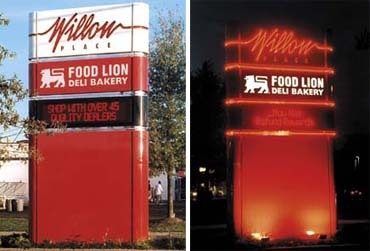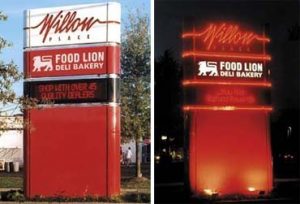Greetings, from the floor of the ISA 2001 International Sign Expo in Las Vegas, where the technology of the day is the light-emitting diode (LED). Wow! A total of 42 vendors displayed their LED offerings — video screens, message displays, room-rate changers and gas-price indicators, lighting systems and pixel clusters. The day of the incandescent lamp as a moving-message component may have gone the way of the dinosaur. LED history The light-emitting diode has slowly evolved since 1976, when it first appeared in the form of scrolling red messages on a black field. In the ’80s, it evolved into a three-color offering — red, yellow-green, amber — or combinations of the three colors. Those of us selling incandescent displays came to think of the LED as the indoor technology." Not until the late ’80s did LEDs emerge as a suitable outdoor technology, again, first in red pixels, and later in the three-color format. The ’90s brought about the first true-color LED displays with the development of blue and true-green LEDs. These components were the missing link that prevented LEDs from serving as a suitable video medium. By 1996, blue and green LEDs had developed sufficient brightness for LED video screens and full-color animation displays to become practical. By 1998, more than 50 companies produced these products. What is an LED? Simply put, the light-emitting diode is a solid-state device, much different than an incandescent lamp. It comprises an alloy crystal placed into a reflective cup and chemically bonded to tiny wires, then encapsulated in epoxy. When electric current runs through those wires, the crystal material is excited. That excitement is dissipated in the form of energy, a small part of which is heat, most of which is in the form of light. Different alloys produce different colors. Each has its own life span and brightness. LEDs’ potential as a sign medium and light source has been known from the start. Sourcing the proper chemicals and alloys has triggered intense research for many years. The future of all forms of illumination is at stake. The perfect source Moving-message signs have always relied on light. Projecting a message, visible from any distance, requires illumination, either direct or reflected, sufficiently visible in the prevailing ambient light. During the last 50 years, incandescent lamps provided the light for most displays. Certainly bright enough, the product brought inherent difficulties and expense. Illumination from a fragile filament meant a short and tentative existence in ideal conditions. In an outdoor environment, more durable sign lamps, even specially produced, lasted but 5,000 hours. In comparison, smaller xenon lamps expire after 20,000 hours. That short life means replacement cost and added labor. The greatest expense comes from the inordinately high energy requirements of a lamp system. A standard 18-in.-character outdoor message display typically utilizes 30-watt lamps. Arrayed into a matrix of 896 lamps for a simple double-faced display, such a sign would have a full-connected load of 19,353 Kilowatts per month. Even adjusting for dimming at night and the limited patterns of illumination formed by text, a simple sign could consume $600 per month in electricity. A Las Vegas spectacular could cost as much as $30,000 per month in electrical expense. By contrast, the LED display is extremely operationally conservative. Modern LEDs are projected to last more than 100,000 hours with proper usage. The cost of electricity for an LED display is only about 3% of incandescent usage, for comparable illumination. If you do the math on those comparisons, it’s easy to recognize why the LED is such an important sign resource. Which brings us back to the 42 vendors at the ISA Sign Expo. How to select a vendor How does a sign company choose an LED supplier? Among many vendors are numerous off-shore companies with totally different sales approaches and customs. Tony Van de Van, president of Lighthouse Technologies Ltd., estimates there are more than 80 current worldwide manufacturers of video-screen technology. Hundreds of other companies produce less complex, moving-message technologies. Most of these firms view the United States as the world’s greatest sales opportunity and bring their products to the American market. I don’t mean to discourage interest in the quality, off-shore display suppliers; many off-shore companies offer excellent products. Nor do I mean to imply that all U.S. suppliers are worthy of your dollar — some are weak, at best. The point is, selecting a visual product requires risk. Ultimately, you must maintain it. Therefore, I’ve assembled a basic checklist to assist in your product selection (see sidebar). As new products settle into the marketplace, business dynamics dictate that most of these producers will go by the wayside. The sign reseller is caught in a nasty Catch-22. The moving-message industry grows by leaps and bounds, driven by LED as a high-quality display medium. The definition of a "sign" will blur over the coming years. For those interested in the future, the time to learn about LED is now. We will see less plastic and metal and more changeable electronics. And the selection of a vendor is more important with this product than with any other. If you start with the 10 simple questions noted in the sidebar, you can quickly flush out the non-contenders. Once you have narrowed the field to a handful of quality providers, you can then focus on features, terms and the normal criteria with which you select vendors. The LED industry slowly came of age. Now it appears to be the viable technology for the next two or three decades. Now is the time to study the technology, its applications and available suppliers. I can assure you, the investment in time will be well worth it.



 Tip Sheet2 weeks ago
Tip Sheet2 weeks ago
 Photo Gallery4 days ago
Photo Gallery4 days ago
 Ask Signs of the Times6 days ago
Ask Signs of the Times6 days ago
 Real Deal2 weeks ago
Real Deal2 weeks ago
 Paula Fargo1 day ago
Paula Fargo1 day ago
 Benchmarks1 week ago
Benchmarks1 week ago
 Photo Gallery1 day ago
Photo Gallery1 day ago
 Women in Signs2 weeks ago
Women in Signs2 weeks ago










